PTRF/Cavin-1 enhances chemo-resistance and promotes temozolomide efflux through extracellular vesicles in glioblastoma
- PMID: 35673568
- PMCID: PMC9169358
- DOI: 10.7150/thno.71763
PTRF/Cavin-1 enhances chemo-resistance and promotes temozolomide efflux through extracellular vesicles in glioblastoma
Abstract
Background: The concentration and duration of intracellular drugs have always been the key factors for determining the efficacy of the treatment. Efflux of chemotherapeutic drugs or anticancer agents is a major reason for multidrug resistance generation in cancer cells. The high expression of polymerase I and transcript release factor (PTRF) is correlated with a worse prognosis in glioma patients. However, the importance of PTRF on temozolomide (TMZ) resistance in glioblastoma (GBM) is poorly understood. Methods: TCGA data analysis, CGGA data analysis, transmission electron microscopy (TEM), scanning electron microscopy (SEM), clone formation, cell counting kit-8 (cck-8), western blot (WB), immunofluorescence (IF), immunohistochemistry (IHC) and flow cytometry assays were performed to investigate the underlying mechanism and effect of PTRF on TMZ-resistance in a variety of GBM cell lines and GBM patient-derived xenograft (PDX) models. Clone formation, WB, IF, IHC and flow cytometry assays were performed to examine the efficacy of sequential therapy of TMZ followed by CQ in GBM cells and PDX models. Results: The prognosis of GBM patients treated with TMZ was negatively correlated with PTRF expression. Our results reveal that PTRF knockdown significantly decrease proliferation and increase apoptosis in GBM after TMZ treatment. Moreover, PTRF contribute to TMZ-resistance by increasing TMZ efflux through extracellular vesicles (EVs). Furthermore, our results demonstrate that sequential therapy of TMZ followed by CQ significantly promotes the TMZ efficacy against GBM by increasing intracellular TMZ concentration ([TMZ]i). Conclusion: This study highlights that PTRF can act as an independent biomarker to predict the prognosis of GBM patients after TMZ treatment and describes a new mechanism contributing to TMZ-resistance. In addition, this study may provide a novel idea for GBM therapy.
Keywords: Glioblastoma; PTRF; chloroquine; extracellular vesicles; temozolomide.
© The author(s).
Conflict of interest statement
Competing Interests: The authors have declared that no competing interest exists.
Figures

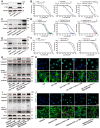
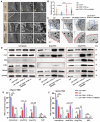
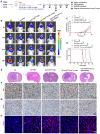
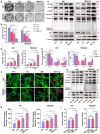
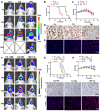
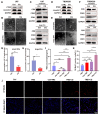

Similar articles
-
Extracellular vesicles carry miR-27a-3p to promote drug resistance of glioblastoma to temozolomide by targeting BTG2.Cancer Chemother Pharmacol. 2022 Feb;89(2):217-229. doi: 10.1007/s00280-021-04392-1. Epub 2022 Jan 17. Cancer Chemother Pharmacol. 2022. PMID: 35039898
-
TTK Protein Kinase promotes temozolomide resistance through inducing autophagy in glioblastoma.BMC Cancer. 2022 Jul 18;22(1):786. doi: 10.1186/s12885-022-09899-1. BMC Cancer. 2022. PMID: 35850753 Free PMC article.
-
Nuclear factor I A promotes temozolomide resistance in glioblastoma via activation of nuclear factor κB pathway.Life Sci. 2019 Nov 1;236:116917. doi: 10.1016/j.lfs.2019.116917. Epub 2019 Oct 12. Life Sci. 2019. PMID: 31614149
-
Involvement of Intracellular Cholesterol in Temozolomide-Induced Glioblastoma Cell Death.Neurol Med Chir (Tokyo). 2018 Jul 15;58(7):296-302. doi: 10.2176/nmc.ra.2018-0040. Epub 2018 Jun 13. Neurol Med Chir (Tokyo). 2018. PMID: 29899179 Free PMC article. Review.
-
Dysregulated lipid metabolism in TMZ-resistant glioblastoma: pathways, proteins, metabolites and therapeutic opportunities.Lipids Health Dis. 2023 Aug 3;22(1):114. doi: 10.1186/s12944-023-01881-5. Lipids Health Dis. 2023. PMID: 37537607 Free PMC article. Review.
Cited by
-
Alterations in cellular metabolism under different grades of glioma staging identified based on a multi-omics analysis strategy.Front Endocrinol (Lausanne). 2023 Dec 4;14:1292944. doi: 10.3389/fendo.2023.1292944. eCollection 2023. Front Endocrinol (Lausanne). 2023. PMID: 38111705 Free PMC article. Review.
-
Exosomes in the Chemoresistance of Glioma: Key Point in Chemoresistance.J Cell Mol Med. 2025 Feb;29(4):e70401. doi: 10.1111/jcmm.70401. J Cell Mol Med. 2025. PMID: 39950738 Free PMC article. Review.
-
Extracellular vesicles in anti-tumor drug resistance: Mechanisms and therapeutic prospects.J Pharm Anal. 2024 Jul;14(7):100920. doi: 10.1016/j.jpha.2023.12.010. Epub 2023 Dec 16. J Pharm Anal. 2024. PMID: 39104866 Free PMC article. Review.
-
EPIC-1042 as a potent PTRF/Cavin1-caveolin-1 interaction inhibitor to induce PARP1 autophagic degradation and suppress temozolomide efflux for glioblastoma.Neuro Oncol. 2024 Jan 5;26(1):100-114. doi: 10.1093/neuonc/noad159. Neuro Oncol. 2024. PMID: 37651725 Free PMC article.
-
Phospholipases in Gliomas: Current Knowledge and Future Perspectives from Bench to Bedside.Biomolecules. 2023 May 7;13(5):798. doi: 10.3390/biom13050798. Biomolecules. 2023. PMID: 37238668 Free PMC article. Review.
References
-
- Back MF, Ang E, Ng W-H, See S-J, Lim C, Chan SP. et al. Improved median survival for glioblastoma multiforme following introduction of adjuvant temozolomide chemotherapy. Ann Acad Med Singap. 2007;36:338–42. - PubMed
-
- Stupp R. European Organisation for Research and Treatment of Cancer Brain Tumor and Radiotherapy Groups; National Cancer Institute of Canada Clinical Trials Group. Radiotherapy plus concomitant and adjuvant temozolomide for glioblastoma. N Engl J Med. 2005;352:987–96. - PubMed
-
- Mayor S, Chadda R. PTRF triggers a cave in. Cell. 2008;132:23–4. - PubMed
Publication types
MeSH terms
Substances
LinkOut - more resources
Full Text Sources
Medical
Miscellaneous

